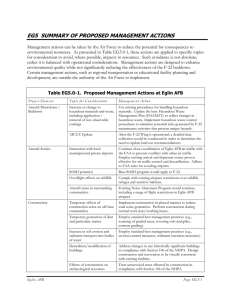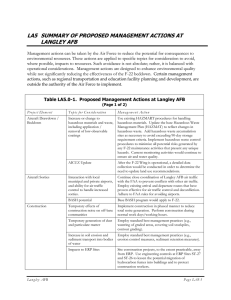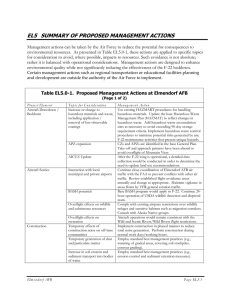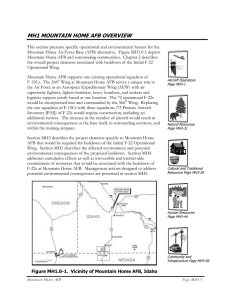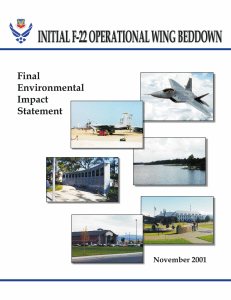MH2 MOUNTAIN HOME AFB ALTERNATIVE
advertisement
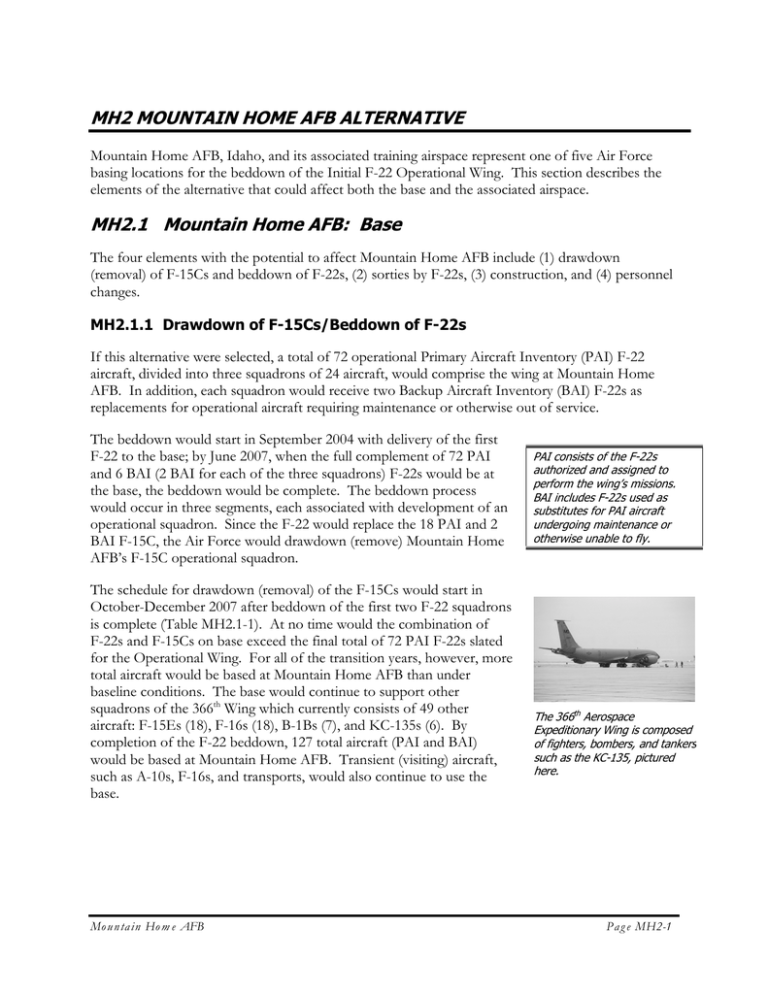
MH2 MOUNTAIN HOME AFB ALTERNATIVE Mountain Home AFB, Idaho, and its associated training airspace represent one of five Air Force basing locations for the beddown of the Initial F-22 Operational Wing. This section describes the elements of the alternative that could affect both the base and the associated airspace. MH2.1 Mountain Home AFB: Base The four elements with the potential to affect Mountain Home AFB include (1) drawdown (removal) of F-15Cs and beddown of F-22s, (2) sorties by F-22s, (3) construction, and (4) personnel changes. MH2.1.1 Drawdown of F-15Cs/Beddown of F-22s If this alternative were selected, a total of 72 operational Primary Aircraft Inventory (PAI) F-22 aircraft, divided into three squadrons of 24 aircraft, would comprise the wing at Mountain Home AFB. In addition, each squadron would receive two Backup Aircraft Inventory (BAI) F-22s as replacements for operational aircraft requiring maintenance or otherwise out of service. The beddown would start in September 2004 with delivery of the first F-22 to the base; by June 2007, when the full complement of 72 PAI and 6 BAI (2 BAI for each of the three squadrons) F-22s would be at the base, the beddown would be complete. The beddown process would occur in three segments, each associated with development of an operational squadron. Since the F-22 would replace the 18 PAI and 2 BAI F-15C, the Air Force would drawdown (remove) Mountain Home AFB’s F-15C operational squadron. The schedule for drawdown (removal) of the F-15Cs would start in October-December 2007 after beddown of the first two F-22 squadrons is complete (Table MH2.1-1). At no time would the combination of F-22s and F-15Cs on base exceed the final total of 72 PAI F-22s slated for the Operational Wing. For all of the transition years, however, more total aircraft would be based at Mountain Home AFB than under baseline conditions. The base would continue to support other squadrons of the 366th Wing which currently consists of 49 other aircraft: F-15Es (18), F-16s (18), B-1Bs (7), and KC-135s (6). By completion of the F-22 beddown, 127 total aircraft (PAI and BAI) would be based at Mountain Home AFB. Transient (visiting) aircraft, such as A-10s, F-16s, and transports, would also continue to use the base. Mountain Home AFB PAI consists of the F-22s authorized and assigned to perform the wing’s missions. BAI includes F-22s used as substitutes for PAI aircraft undergoing maintenance or otherwise unable to fly. The 366th Aerospace Expeditionary Wing is composed of fighters, bombers, and tankers such as the KC-135, pictured here. Page MH2-1 Initial F-22 Operational Wing Beddown Draft EIS Table MH2.1-1. Proposed F-22 Beddown and F-15C Drawdown Schedule: Mountain Home AFB Based F-15C PAI Aircraft Based F-22 PAI Aircraft Total PAI Aircraft Baseline 18 0 18 2004 18 7 25 2005 18 32 50 2006 14 58 72 2007 0 14 72 The 366th Wing at Mountain Home AFB is under the Air Force’s Expeditionary Air Force (EAF) Construct. The EAF Construct grew out of the need for the United States to deploy forces worldwide despite the reduction in United States overseas basing and personnel. Under the EAF, the Air Force has divided its forces into 10 Aerospace Expeditionary Forces (AEFs) and 2 AEWs to make worldwide deployments more predictable and manageable. MH2.1.2 Sorties The 366th Wing is one of two AEWs designed for crisis response. While not part of the EAF program, the 366th Wing serves as another important pillar of United States defense in its role as an AEW. This role involves overseas deployments for the 366th Wing, as well as for its individual squadrons (like the F-15C squadron). Each AEW is eligible for deployment for 90 days every other 120 days. The F-22 squadrons would be incorporated into and commanded by the 366th Wing, which would retain its overall AEW role. However, the operational F-22 squadrons would also be integrated into the Air Force’s EAF Construct as individual squadrons under an AEF. An AEF is a “package” (group of different types of aircraft with a mix of capabilities suited to the tasking) deployed to overseas locations for about 90 days. These AEFs consist of wings or squadrons from multiple United States bases and may operate as a unit or be integrated with other forces overseas. Pre- and/or post-deployment training at locations other than a “home” base cover approximately another 30 days out of the year. Squadrons or wings at the bases are rotated into the AEF program on a 15-month cycle. A sortie is the flight of a single aircraft from takeoff through landing. By completion of the beddown of aircraft, the Initial F-22 Operational Wing would fly 11,187 sorties per year from Mountain Home AFB Beddown of F-22s at (Table MH2.1-2). Based on projected requirements and deployment Mountain Home AFB would increase overall sorties by patterns, the F-22 squadrons would fly an additional 5,760 sorties at 58 percent. overseas airfields during deployments or at other locations for exercises or in preparation for deployments. On average, each squadron (24 PAI aircraft) would be deployed for 120 days per year (90 days AEF and 30 days pre- or post-AEF Page MH2-2 Mountain Home AFB Initial F-22 Operational Wing Beddown Draft EIS training); this equates to a single squadron being deployed all year. In addition, each squadron would participate in training exercises and operate out of another United States or overseas base for an average of one week per year, flying another 333 (or 111 sorties per squadron) sorties at remote locations other than Mountain Home AFB. Some of these remote sorties would involve ordnance delivery training or missile firing at approved ranges, such as the Nellis Range Complex in Nevada, Utah Test and Training Range, or Eglin AFB’s over-water ranges in the Gulf of Mexico. The 11,187 F-22 sorties at Mountain Home AFB would represent an increase of 8,595 sorties over baseline levels. This increase would result from two factors: 54 more aircraft (72 F-22s versus the 18 F-15Cs) and the increased sortie rate of F-22s (20 sorties per aircraft per month) as compared to the F-15C (18 sorties per aircraft per month). Total sorties would still remain below those analyzed previously (Air Force 1998a) for the base. Table MH2.1-2. Comparison of Baseline F-15C and Projected F-22 Annual Sorties Baseline Sorties Projected Sorties F-15C 2,592 F-22 11,187 Total All Aircraft1 14,758 Total All Aircraft1 23,353 Note: 1. Includes 12,166 sorties by other based and transient aircraft. In 2007, with completion of the beddown, the F-22s would perform about 48 percent of all sorties at the base. Currently, the F-15Cs account for 18 percent of the total sorties. The F-22s would employ similar departure and landing procedures as currently used by the F-15Cs at the base. F-22 operations would adhere to existing restrictions, avoidance procedures, and the quiet-hours program (10:30 pm to 6:30 am) at Mountain Home AFB. However, the F-22’s power would allow it to accelerate more quickly to climb speed and reduce power sooner past the departure end of the runway. In contrast, the F-15C maintains a higher power setting throughout its climb. Overall, this capability of the F-22 would result in lower noise exposure in the airfield environment as the aircraft takes off. The F-22 would fly the same percentage (30 percent) of sorties after dark (i.e., about 1 hour after sunset) as the F-15Cs under the Air Force’s Environmental night (10:00 initiative to increase readiness. Approximately 5 percent (out of the total pm to 7:00 am) is the period when the effects of aircraft 30 percent) of the after-dark sorties are expected to occur during noise on people are environmental night (10:00 pm to 7:00 am), which is identical to the accentuated. F-15Cs, while the rest of the after-dark sorties are expected to occur about 1 hour after sunset. While the percentages of environmental night operations would not change with beddown of operational F-22s, the total annual sorties during this period would increase by 429, or by less than 2 per flying day (260 flying days per year). The F-15Cs use the afterburner to take off about 40 percent of the time. In contrast, the F-22s are expected to use the afterburner 5 percent or less of the time to take off. Mountain Home AFB Page MH2-3 Initial F-22 Operational Wing Beddown Draft EIS MH2.1.3 Construction Additional infrastructure and facilities would be required at Mountain Home AFB to support F-22 operations (Table MH2.1-3). A total of 31 construction, modification, or infrastructure improvement projects directly related to the beddown would be implemented from 2002 to 2004 (Figure MH2.1-1). Most construction would occur in 2002 and 2003. In total, the construction, modifications, and infrastructure improvements would affect about 440 acres and cost approximately $395.2 million. Affected acres represent the area covered by the construction footprints of the proposed facilities plus the surrounding lands where construction-related clearing and grading would occur. Infrastructure upgrades, such as connecting new facilities to water and power systems, would also add to the affected areas on the base. F-22 buildings, including the parts store and weapons load trainer, would be to the left (southeast) of the B-1B hangars shown in this picture. Construction of a second runway parallel to the existing runway, 600 housing units, additional aircraft parking apron, and three new maintenance hangars represent the most substantial construction projects proposed at Mountain Home AFB. These projects account for 84 percent of the affected acres. Construction of the runway would occur parallel and west of the existing runway. The new housing units would be located in the northeast corner of the base, near the existing base housing area. Most other construction and modification projects would be located along the flightline and supporting industrial area in the southeastern portion of the bases (see Figure MH2.1-1). As an indirect result of the beddown construction, the base would likely need to relocate the existing wastewater treatment plant and storage lagoon (not listed in Table MH2.1-3) on the western edge of the base to accommodate the northern end of the new runway. A potential location for the relocated facility would be in the open area in the northcentral portion of the base. This relocation could affect approximately 30 acres. MH2.1.4 Personnel Changes Beddown of the Initial F-22 Operational Wing at Mountain Home AFB would require basing 1,846 personnel to operate and maintain the wing Base personnel would increase by 24 percent and to provide necessary support services. Fewer personnel, particularly as a result of the for maintenance, would be needed for the F-22 wing than for an beddown. equivalent number of F-15C aircraft. For Mountain Home AFB, the F-22 personnel positions would be drawn from the equivalent positions associated with existing F-15C manpower authorizations. As such, total personnel would increase by 1,201 because the base currently supports only one F-15C squadron (Table MH2.1-4). Page MH2-4 Mountain Home AFB Initial F-22 Operational Wing Beddown Draft EIS Table MH2.1-3. Proposed Construction and Modification for Mountain Home AFB Year 2002 2002 2002 2002 2002 2002 2002 2002 2002 2002 2002 2002 2002 2002 2002 2002 2002 2002/03/04 2002/03/04 2002/03/04 2002/03/04 2003 2003 2003 2003/04 2003/04 2003/04 2003/04 2003/04 2004 2002/03/04 Description Low Observable/Composite Repair Facility Fighter Squadron Operations Maintenance Hangar Flight Simulator Building Engine Shop Storage Armament Building Fuel Cell Hangar Parts Store Hush House Foundation Vertical Tank Storage PMEL Weapons Loading Trainer Munitions Administration Facility 20 MM Ammunition Storage Expanded Fuel Operations Facility Maintenance Training Detachment Facility Aircraft Apron Second Runway and Taxiways Three-Bay Munitions Maintenance Facility Dormitory On-Base Housing (600 Units) Roads, Storm Drains, Parking1 Child Care Facilities Dining Hall Fighter Squadron Operations/Maintenance Hangar Fitness Center Transportation, Civil Engineering Squadron, Supply Various (Family Services, Ed Center) Recreation Center Temporary Lodging Facility Fighter Squadron Operations/Maintenance Hangar Associated Utilities/Infrastructure Action Construct Construct Affected Area In Acres 1.96 3.42 Construct Construct Construct Construct Construct Construct Construct Construct Construct Construct Construct Upgrade Construct Construct Construct Construct Construct Construct Construct Construct Construct Construct 0.98 0.46 0.58 1.10 2.66 0.046 0.66 0.22 0.82 0.46 0.28 NA 0.56 10.94 206.61 0.60 3.22 150.00 NA 1.20 0.46 3.42 Construct Construct 1.14 1.04 Construct Construct Construct Construct 1.14 0.42 1.98 3.42 Construct Total 39.97 ≈440 Note: 1. Affected area included in other facility totals. Mountain Home AFB Page MH2-5 Initial F-22 Operational Wing Beddown Draft EIS Table MH2.1-4. Proposed Personnel Changes: Mountain Home AFB Baseline Personnel F-15C Baseline Personnel Total Projected Personnel F-22 Projected Personnel Total Total Change in Personnel September 2004 – August 2005 September 2005 – June 2006 September 2006 – June 2007 CHANGE PER BEDDOWN PHASE1 Officer 38 512 169 643 +131 +43 +44 +44 Enlisted 607 3,604 1,598 4,595 +991 +330 +330 +331 Civilian 0 877 791 9561 +79 +26 +26 +27 Total 645 4,993 1,846 6,194 +1,201 +399 +400 +402 Note: 1. Includes 54 contractor personnel. The Air Force expects that the changes in personnel needed for the beddown would occur in three phases associated with the establishment of the three squadrons (refer to Table MH2.1-1), starting in September 2004 and ending by June 2007. MH2.2 Mountain Home AFB: Training Airspace MH2.2.1 Airspace Use As the replacement for the F-15Cs at Mountain Home AFB, the F-22 would conduct the same types of missions and training programs. The Air Force expects that the F-22 would use the training airspace associated with Mountain Home AFB in a manner similar to the F-15C operational squadron’s current use of the airspace. All F-22 flight activities would take place in existing airspace; no airspace modifications would be required for the F-22. Members of the public expressed concern that replacing the F-15C with the F-22s at Mountain Home AFB could require changes to existing airspace. Because the two aircraft have similar missions, no airspace changes are required. Training for the F-22s, like the F-15Cs, would be conducted in Military Operations Areas (MOAs) and overlying Air Traffic Control Assigned Airspace (ATCAA). The affected airspace units for the Mountain Home AFB alternative consist of five MOAs (Jarbidge, Owyhee, Paradise East, Paradise West, and Saddle) with overlying ATCAAs (Table MH2.2-1 and Figure MH2.2-1). Used on a continuing basis for local training, this airspace receives 100 percent of current F-15C sortie-operations and would continue at the same percentage for the F-22s under the proposed beddown. Aircraft conducting air-to-air training commonly schedule and use the Jarbidge and Owyhee MOAs as one unit. Often, during exercises, Paradise East and West MOAs are also included. With its air-to-air mission, the F-22 would follow this pattern of use. Mountain Home AFB A sortie-operation is one use of a single airspace unit by one aircraft. Page MH2-7 Initial F-22 Operational Wing Beddown Draft EIS Table MH2.2-1. Baseline and Projected Annual SortieOperations in Airspace Associated with Mountain Home AFB Airspace Unit Floor (feet) Ceiling (feet)1 Jarbidge MOA 100 AGL 18,000 MSL Owyhee MOA 100 AGL 18,000 MSL Paradise East MOA 14,500 MSL 18,000 MSL Paradise West MOA 14,500 MSL 18,000 MSL Saddle MOA 10,000 MSL 18,000 MSL Baseline F-15C Use Total Baseline Use Projected F-22 Use Projected Total Use 1,149 1,633 1,007 1,342 687 8,273 7,846 3,352 4,382 2,169 3,375 4,796 2,958 3,941 2,018 10,499 11,009 5,303 6,981 3,500 Note: 1. ATCAA overlies all of these MOAs extending up to 50,000 feet MSL MSL = mean sea level; AGL = above ground level By completion of the beddown in 2007, total sortie-operations would increase in each of the MOAs and overlying ATCAA by 27 to 61 percent above total baseline levels. The Jarbidge and Owyhee MOAs would receive the lowest percentage increase in use (27 and 40 percent, respectively). Total sortie-operations in the other MOAs (Paradise East, Paradise West, and Saddle) would increase 58, 59, and 61 percent, respectively. Overall, the F-22s would perform 46 percent of total sortieoperations for the five MOAs. In comparison, baseline F-15C use accounts for 22 percent of total sortie-operations. For each of the MOAs, F-22 sortie-operations would be about three times as numerous as those by the F-15Cs under baseline. Such increases correlate directly to the increase in number of aircraft and the increased utilization rate of the F-22s. F-15E, F-16, B-1B, and KC-135 aircraft flown General F-15 and F-22 by the 366th Wing and A-10s flown by the Idaho Altitude Use Air National Guard (Boise, Idaho), would % of Flight % of Flight continue to conduct sortie-operations in all five Altitude Hours: Hours: MOAs and overlying ATCAAs. In the Jarbidge (feet) F-15C F-22 MOA, which encompasses the restricted airspace >30,000 8% 30% for two air-to-ground ranges (Saylor Creek 10,000-30,000 67% 50% Range and Juniper Butte Range), F-15Es, F-16s 5,000-10,000 14% 15% and A-10s would continue as the dominant 2,000-5,000 8% 3.75% users, flying 60 percent of the sortie-operations. 1,000-2,000 2.75% 1% These aircraft would continue to spend 500-1,000 0.25% 0.25% additional time in this MOA to use the ranges. F-22s would fly more of the time at higher altitudes The F-15Cs do not and the F-22s would not use than the F-15Cs now flying in MOAs. the ranges, although they would fly through the ranges’ restricted airspace as part of their use of the MOA. The F-15Es, F-16s, and A-10s combined would continue to dominate use of the Owyhee MOA (52 percent) with F-22s conducting the highest percentage of sortie-operations in the high-altitude Paradise East and West MOAs. A-10s and F-22s Page MH2-8 Mountain Home AFB Initial F-22 Operational Wing Beddown Draft EIS Mountain Home AFB Page MH2-9 Figure MH2.2-1 Airspace Associated with Mountain Home AFB Initial F-22 Operational Wing Beddown Draft EIS would be the largest users of the Saddle MOA, accounting for 18 and 58 percent of the total use, respectively. Like the F-15C aircraft, the F-22 would fly approximately 90-minute-long sorties, including takeoff, transit to and from the training airspace, training activities, and landing. Depending upon the distance and type of training activity, the F-22 would spend between 20 to 60 minutes in the training airspace. In many instances, single sorties would involve the use of more than one MOA for daily training. Because four of five MOAs (except Saddle) abut one another, aircraft may use them in combination to achieve training requirements. On occasion during an exercise, the F-22 may spend up to 90 minutes in a set of MOAs. The F-22 would consistently fly at higher altitudes than the F-15C (Table MH2.2-2), operating mostly (95 percent) at altitudes above 5,000 In Mountain Home AFB feet above ground level (AGL). In comparison, the F-15Cs operate airspace, certain units are above this altitude 83 percent of the time in the MOAs. While the authorized for supersonic Jarbidge and Owyhee MOAs permit flight down to 100 feet AGL, Air flight above 10,000 feet AGL. Force procedures prohibit the F-22 and F-15C from flights below 500 feet AGL. The Air Force also employs seasonal, altitude, and locational restrictions for flight activity below 2,000 feet AGL. Most of these restrictions are implemented to reduce overflight noise over recreationists and certain wildlife species during specific times of the year. Other restrictions apply to avoidance of Native American traditional activities as defined through ongoing government-to-government relations with the Shoshone-Paiutes in southwest Idaho. By agreement, the Air Force conducts no flights over the Duck Valley Reservation below 15,000 feet AGL. Thus, Mountain Home AFB aircraft generally avoid flights over the Duck Valley Reservation. In the other three MOAs (Paradise East, Paradise West, and Saddle), the floors (base altitudes) start well above 5,000 feet AGL, so 100 percent of the flight time would be above this altitude. The F-22 would, on average, fly the same percentage of time (30 percent) after dark as do the F-15Cs that currently use the airspace. About 5 percent of total after-dark operations would continue to occur during environmental night (10:00 pm to 7:00 am). Other users, such as the B-1Bs and F-15Es from the 366th Wing and transients, would continue to account for most of the environmental night operations. Like the F-15Cs, the F-22 would employ supersonic flight within the Owyhee and Jarbidge MOAs where such activity is already authorized. Such activity is not authorized in the other three MOAs. Due to the mission of the F-22 and the aircraft’s capabilities, the Air Force anticipates that approximately 25 percent of the time spent in air combat maneuvers would involve supersonic flight. All supersonic flight would be conducted above 10,000 feet AGL, with 60 percent occurring above 30,000 feet mean sea level (MSL). In comparison, the F-15Cs commonly conduct supersonic flight for about 7.5 percent of the time spent in air combat maneuvers. Most of the F-15C flights are performed between 10,000 feet AGL and 30,000 feet MSL. Supersonic flight would continue to be performed with restrictions, including avoiding the portions of the MOAs overlying the Duck Valley Reservation. Page MH2-10 Mountain Home AFB Initial F-22 Operational Wing Beddown Draft EIS Table MH2.2-2. Baseline and Projected Altitude Use in Airspace Associated with Mountain Home AFB PERCENT TIME OF AVERAGE SORTIEOPERATION (FEET) F-15C/F-22 1,000 – 5,000 5,000 – 10,000 SUPERSONIC AUTHORIZED Airspace Unit1 5001,000 10,000 – 30,000 >30,000 Jarbidge MOA 5/0.25 12/4.75 13/15 62/50 8/30 Yes Owyhee MOA 5/0.25 12/4.75 13/15 62/50 8/30 Yes Paradise East MOA NA NA NA 100/70 0/30 No Paradise West MOA NA NA NA 100/70 0/30 No Saddle MOA NA NA 30/20 70/50 0/30 No Note: 1. Refer to Table MH2.1-5 for floor and ceiling altitudes. MH2.2.2 Defensive Countermeasures Like the F-15Cs, the F-22 would deploy chaff and flares as defensive countermeasures in training. Chaff and flares are the principal defensive mechanisms dispensed by military aircraft to avoid detection or attack by enemy air defense systems. Because of evolving tactics and mission scenarios, the F-22 is expected to use fewer defensive countermeasures (i.e., chaff and flares) per sortie, due to its stealth characteristics. However, because the F-22 is so new, this reduction in chaff and flare use cannot yet be defined. For the purposes of this analysis, it is estimated that the expenditure of chaff and flares by the F-22s would match that of F-15Cs on a per-sortie basis. Chapter 2 (section 2.1.2) provides details on the composition, characteristics, and uses of chaff and flares. Chaff and flare use would continue in the Jarbidge, Owyhee, Paradise East, and Paradise West MOAs. Current restrictions prohibit such use in the Saddle MOA. Numerous seasonal and locational restrictions apply to the use of chaff and, especially, flares in these MOAs (Air Force 1998b). For example, chaff may not be dispensed over the Duck Valley Reservation, and flares are not used at night at any altitude or below 20,000 feet AGL during the day. Under the Mountain Home AFB alternative, F-22s would use up to 41,951 bundles of chaff and up to 22,374 flares per year (in 2007 and after) in the MOAs. In addition, to minimize the risk of inadvertent fires, flares can be released only above 2,000 feet AGL in the MOAs. This release altitude is about three times higher than the minimum safe release altitude. The Air Force also restricts all flare use during periods of Annual Chaff and Flare Use extreme fire danger (Air Force 1998b). This level of use would represent an annual increase of 32,226 bundles of chaff and 17,190 Chaff Flares flares over baseline F-15C use. Chaff and flare use by the F-22s F-15C 9,725 5,184 would follow all current locational, seasonal, and altitude restrictions F-22 41,951 22,374 for the MOAs. Because it would be dispensed at higher altitudes by Change +32,226 +17,190 the F-22s, chaff would disperse more (Air Force 1997), minimizing the amount and size of fibers occurring in any location. Several Baseline and projected chaff use would adhere to current seasonal and altitude restrictions. Mountain Home AFB Page MH2-11 Initial F-22 Operational Wing Beddown Draft EIS factors indicate that flare use by the F-22s would not increase the risk of wildfires. First, as noted above, the F-22 is likely to employ fewer flares than the F-15Cs due to its stealth capabilities. Second, 80 percent of the F-22’s flight activity (including flare use) would occur above 10,000 feet MSL, thereby increasing the margin to ensure complete flare consumption. Third, about 45 percent of the flares would be expended in the Paradise East and West MOAs whose floors prohibit flight below 14,500 feet MSL (or about 6,000 to 10,000 feet AGL). Last, the current altitude restrictions for flare use in the Owyhee and Jarbidge MOAs would still apply. MH2.3 Permits and State Consultation Mountain Home would continue to work closely with federal and state permitting agencies. Air quality permits to construct and operate new stationary sources would be obtained for new or modified sources of regulated pollutants from engine shops, construction and operation of a new Low Observability Composite Repair Facility and other structures. The Idaho Department of Environmental Quality (IDEQ) would receive a wetland mitigation plan for approval with mitigation of impacts to any federally defined jurisdictional wetlands under the Clean Water Act. A National Pollution Discharge Elimination System (NDPES) Permit would be obtained from the IDEQ, for the Resource Conservation and Recovery Act (RCRA) Closure of the Wastewater Treatment Plant and construction of new facilities. An Idaho Land Application Permit would also be obtained for the RCRA Closure of the Wastewater Treatment Plant and the associated wastewater land application. A water well closure permit would also be obtained from the Idaho Department of Water Resources for the closure of two water wells. In addition, the Federal Facilities Agreement with the United States Environmental Protection Agency (USEPA) has the Air Force consulting with the IDEQ regarding any proposed construction near any Environmental Restoration Program (ERP) sites on Mountain Home AFB. MH2.4 Public and Agency Concerns The Initial F-22 Operational Wing Beddown Environmental Impact Statement (EIS) process has undergone an extensive 8-month public scoping period, with 33 scoping meetings in five states. The Air Force publicized the scoping meetings by publishing six meeting notices in local and regional newspapers, sending press releases to area television stations, and placing flyers in community buildings and businesses. In order to ensure maximum opportunity for community dialogue, scoping was conducted in two distinct phases. Sixty-eight people attended the Phase-One and Phase-Two scoping meetings for Mountain Home AFB. The Phase-One scoping meeting was held in Mountain Home, Idaho, on April 11, 2000. The Phase-Two scoping meetings were in Boise on July 25, Twin Falls on July 26, Mountain Home on July 27, and Duck Valley Reservation on August 9. Written comments were received from the public and agencies prior to close of the scoping period. During the scoping meetings, people were given the opportunity to ask questions and provide comments on the Initial F-22 Operational Wing beddown proposal. Some of the inputs include: Page MH2-12 Mountain Home AFB Initial F-22 Operational Wing Beddown Draft EIS • What kind of noise data do you have now comparing the F-22 to the F-15C? (see section MH3.2) • What kinds of facilities would be needed off of the installation? (facility improvement or construction would only occur on base) • How many sonic booms are envisioned over the areas in which the F-22 will train? (see section MH3.2.2) • What kind of runway would Mountain Home AFB require? (see section MH2.1.3) • Will flight rules in the Owyhees change because of the F-22? (Flight rules will stay the same, see section MH2.2.1) • Will the F-22 use flares and chaff? (see section MH2.2.2) • Do these aircraft have lasers? (the F-22s will not have lasers) • You’ve identified Langley AFB as the preferred alternative. What rank is Mountain Home? (Mountain Home AFB is one of the five locations evaluated in this Draft EIS; see Table 2.4-1 and 2.4-2 in Chapter 2 for a comparative analysis) • Does this jet carry any toxic materials like hydrazine that are hazardous? (hydrazine will not be used by the F-22; see section MH3.17) • What kind of support equipment goes with the F-22? (see section MH2.1.3 for basing facilities) • Will the F-22 train differently than the F-15s at Mountain Home? (see section MH2.2.1) • What will they do with the airspace – will there be changes? (see section MH3.1) Mountain Home AFB Page MH2-13 Initial F-22 Operational Wing Beddown Draft EIS Page MH2-14 Mountain Home AFB
